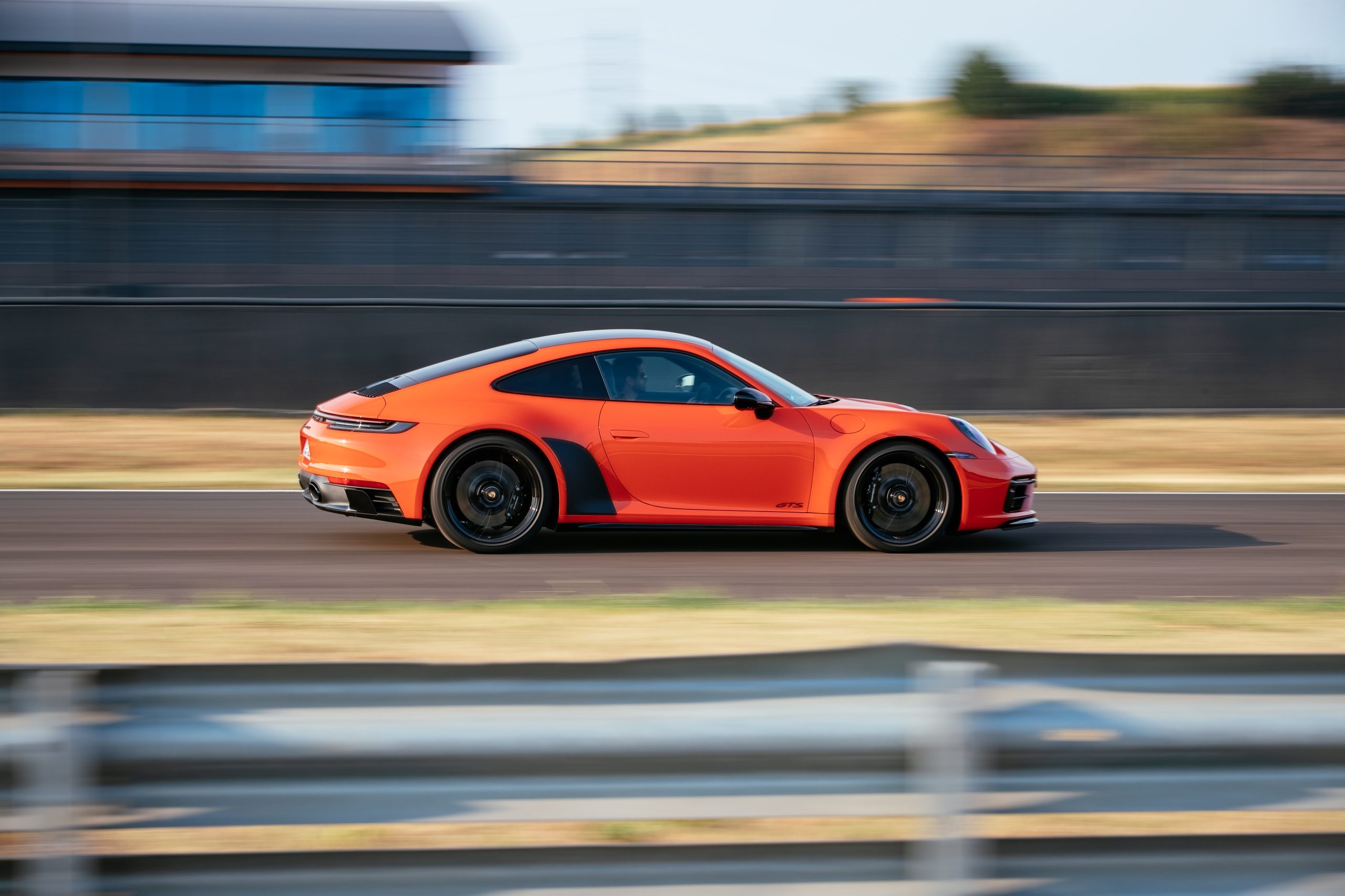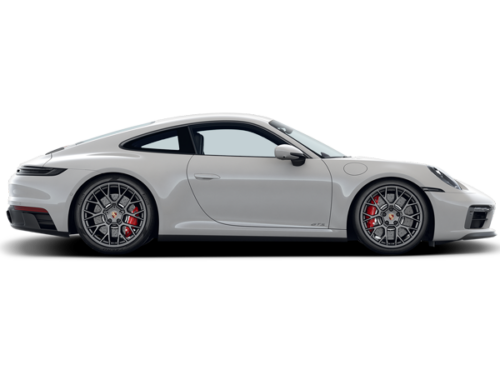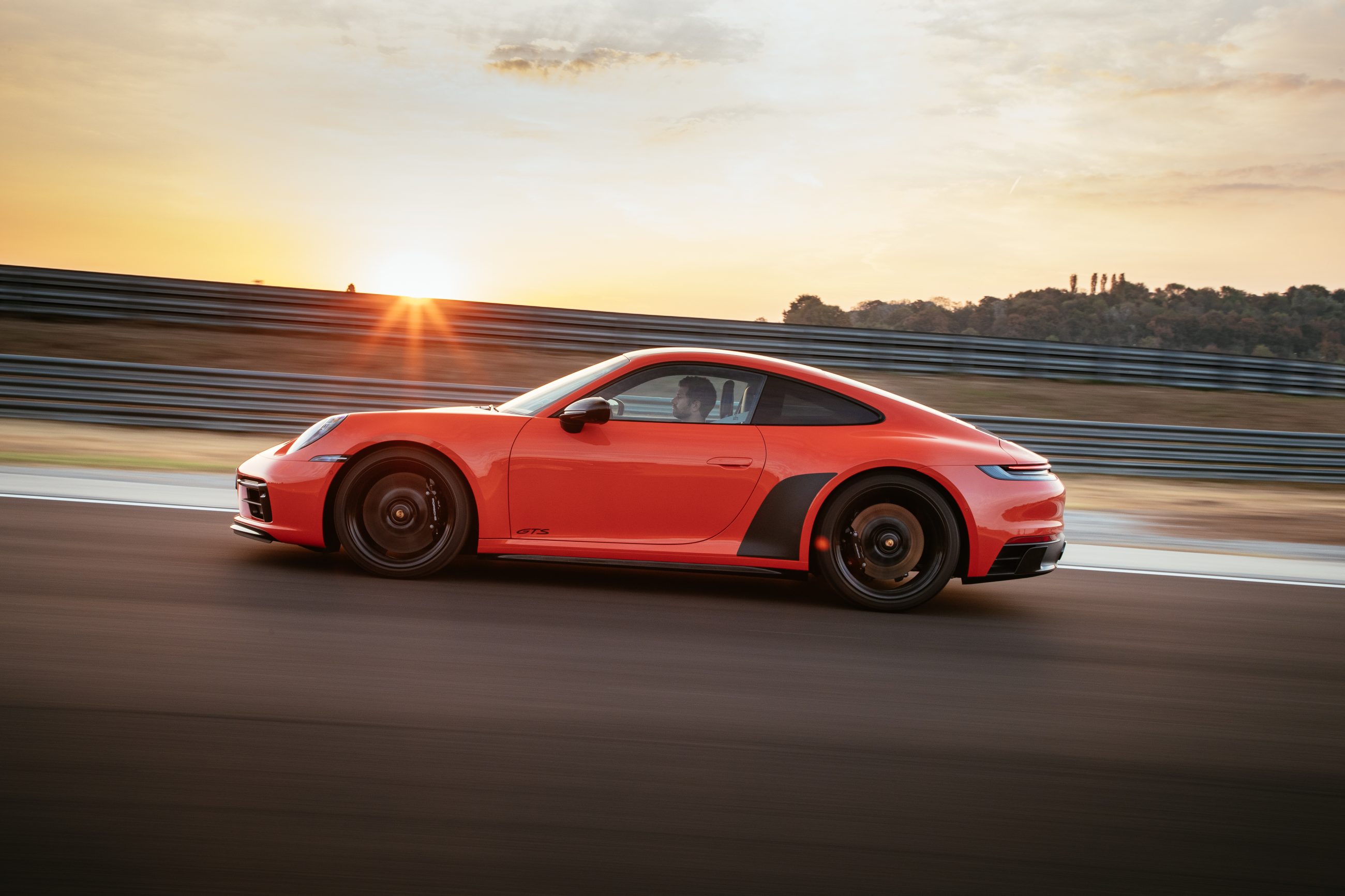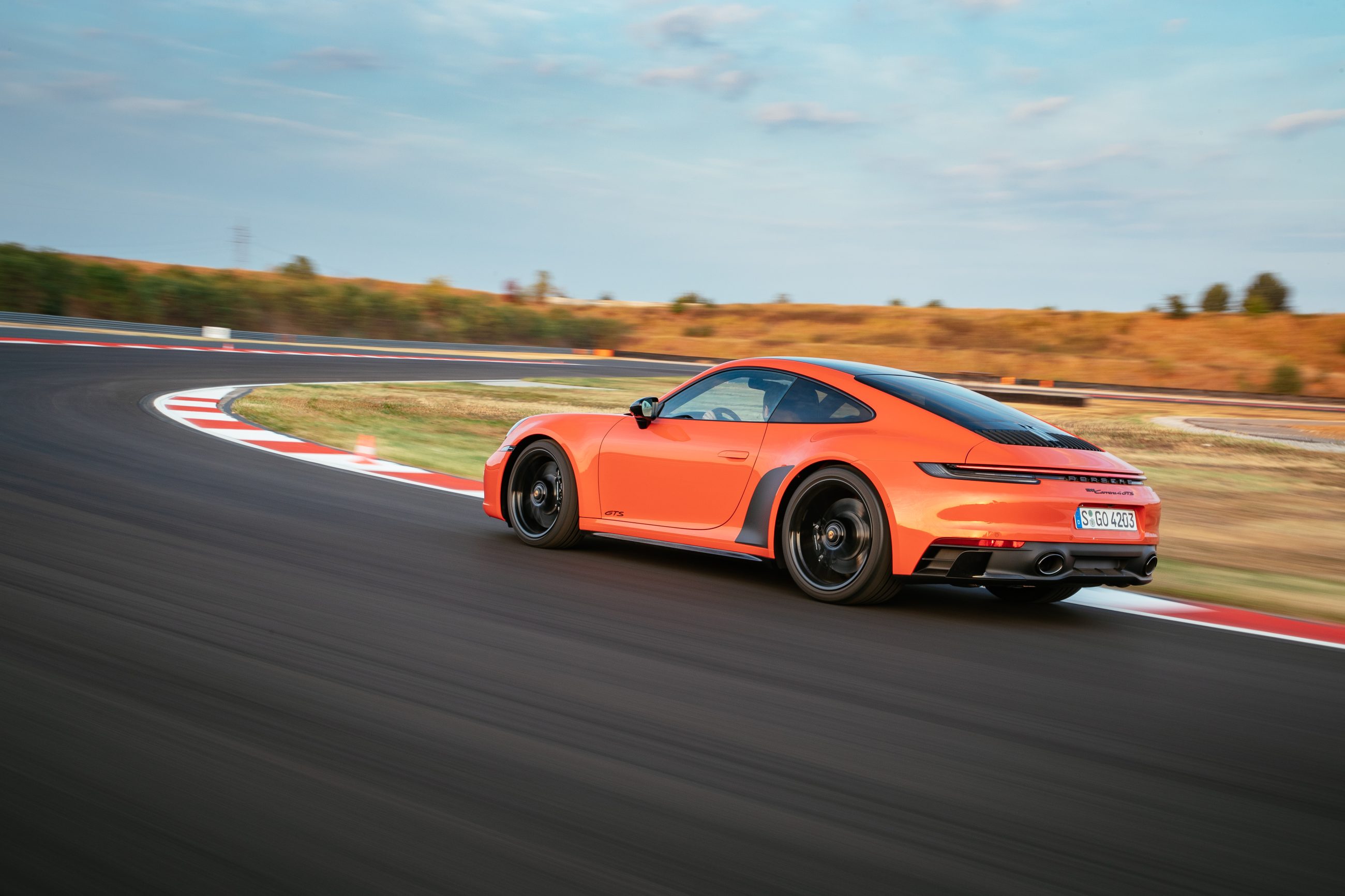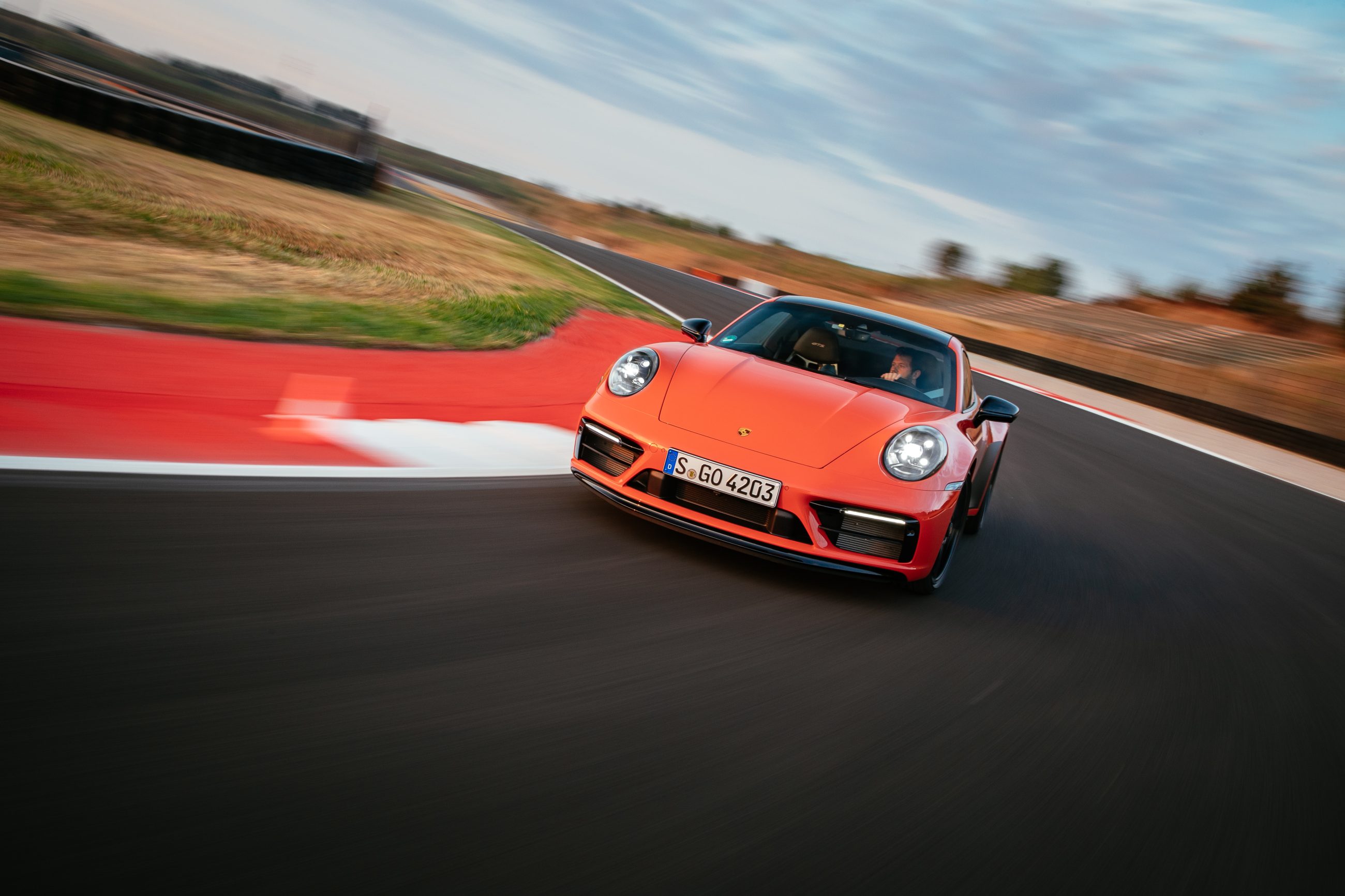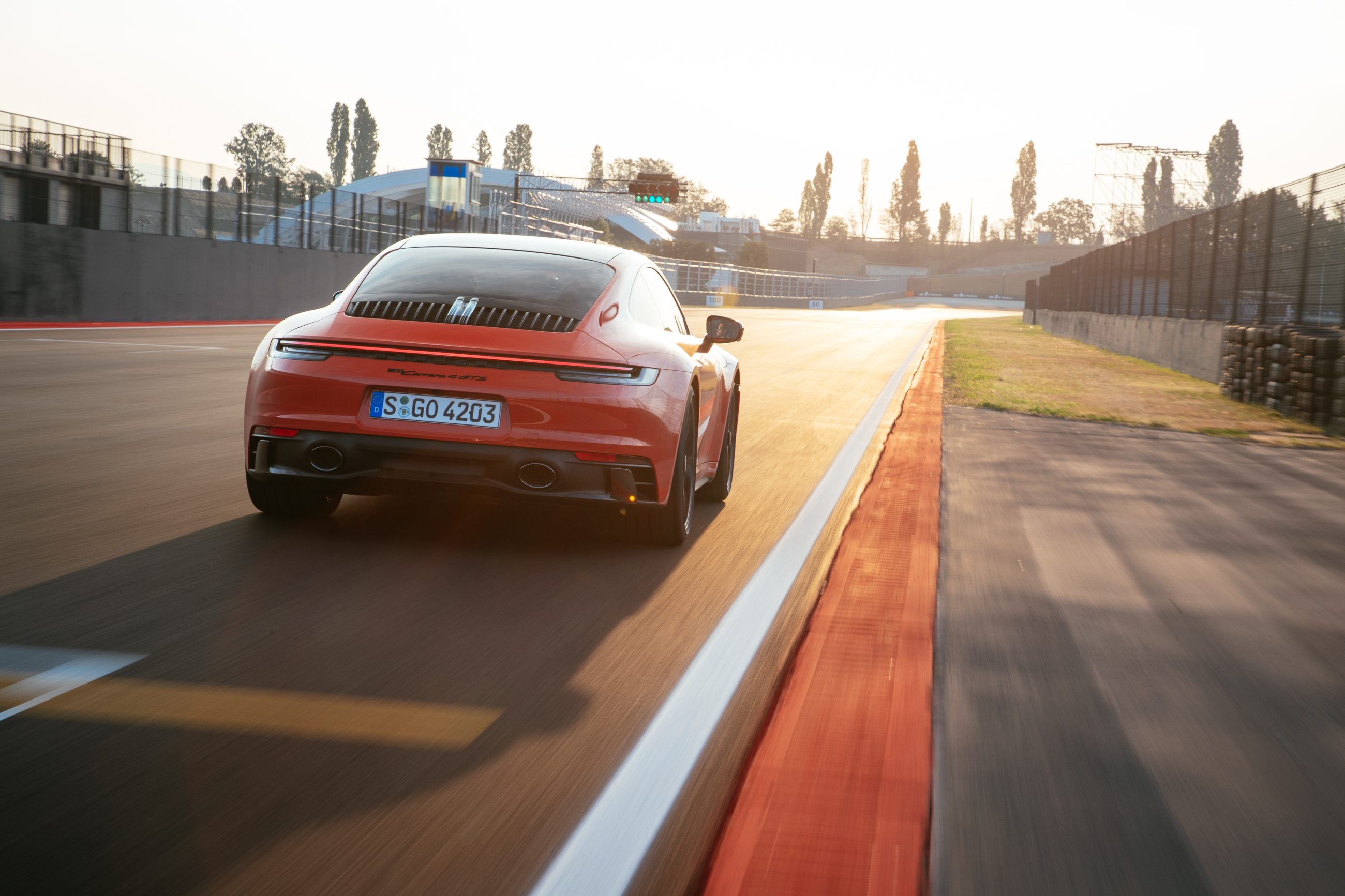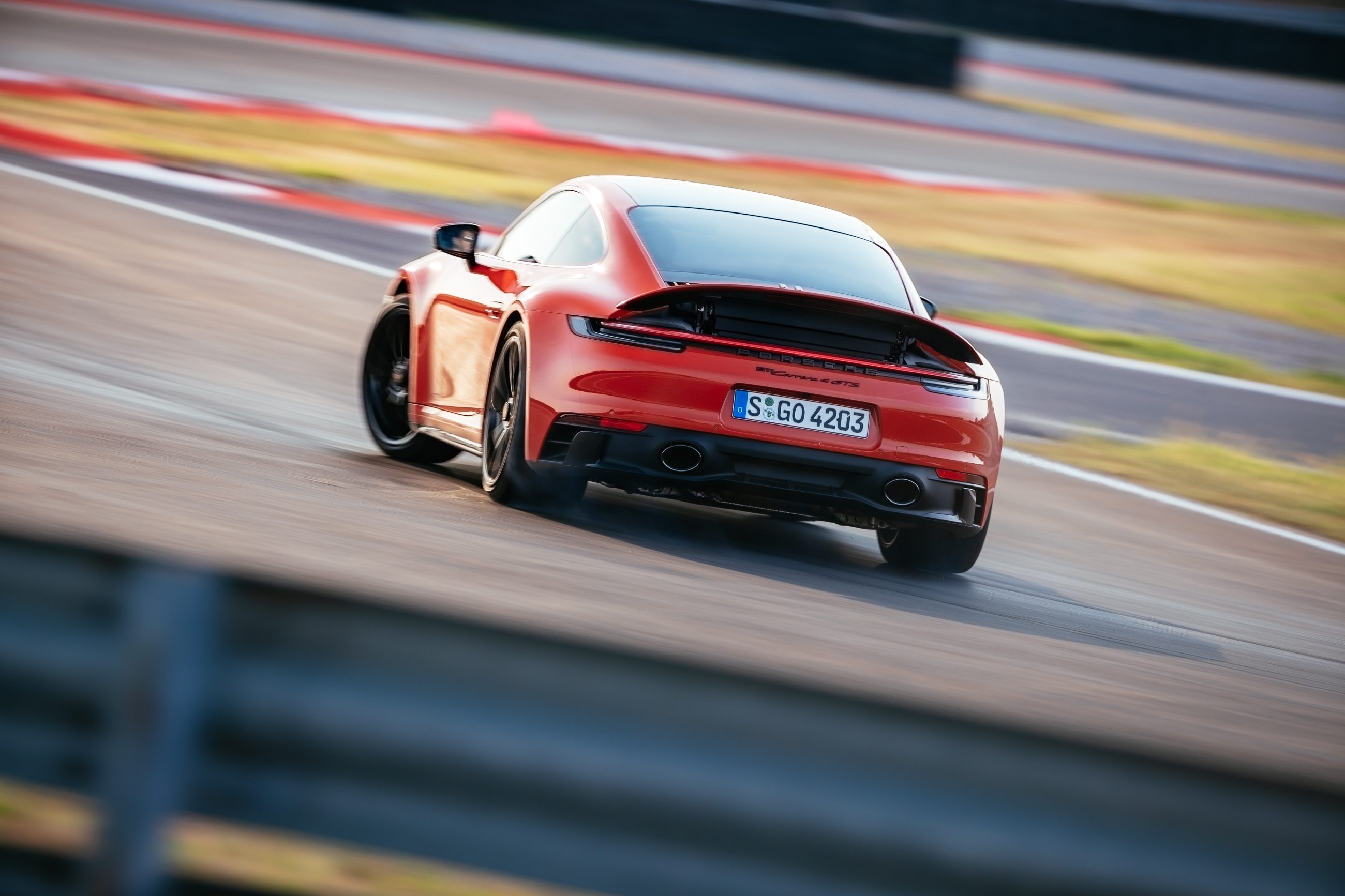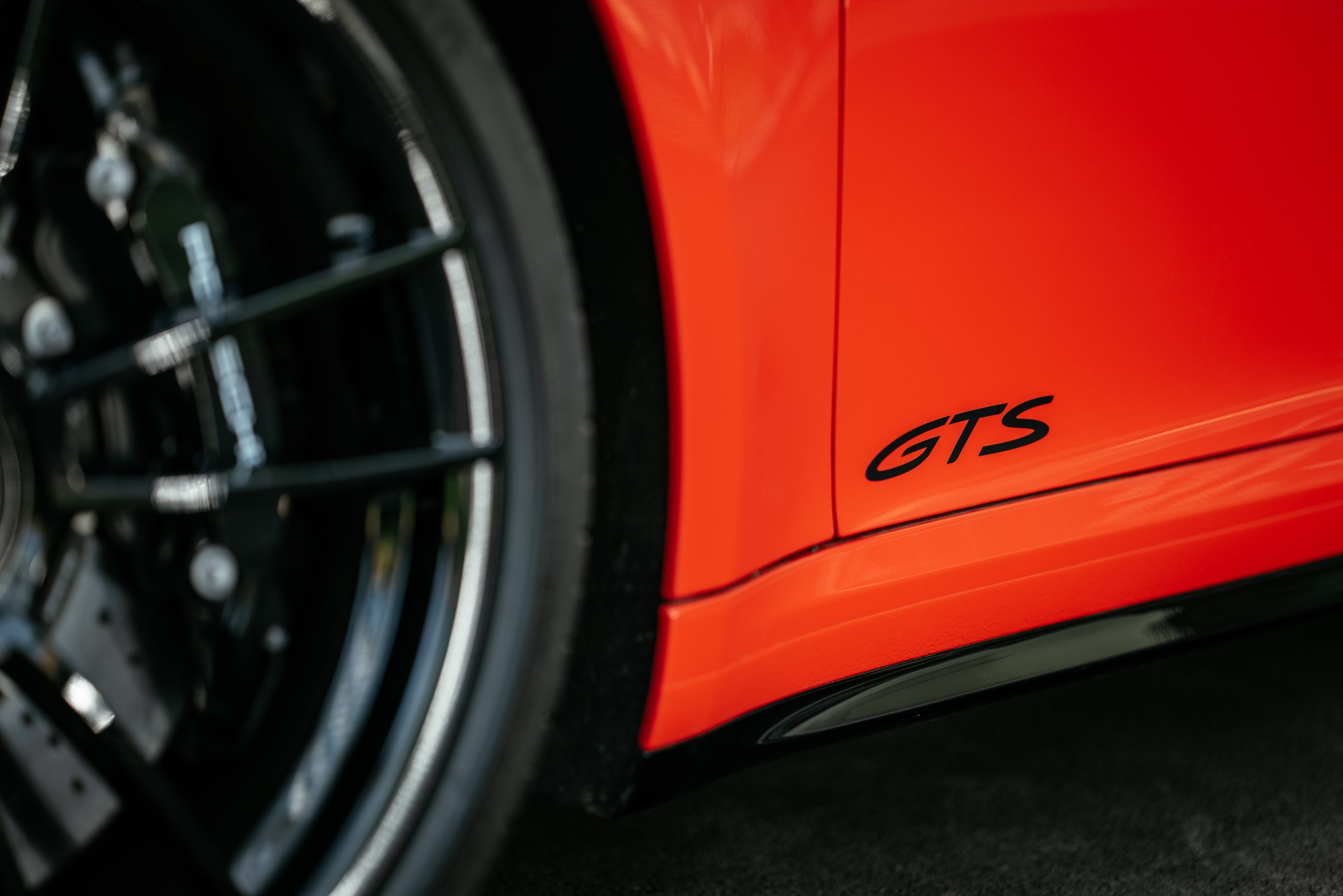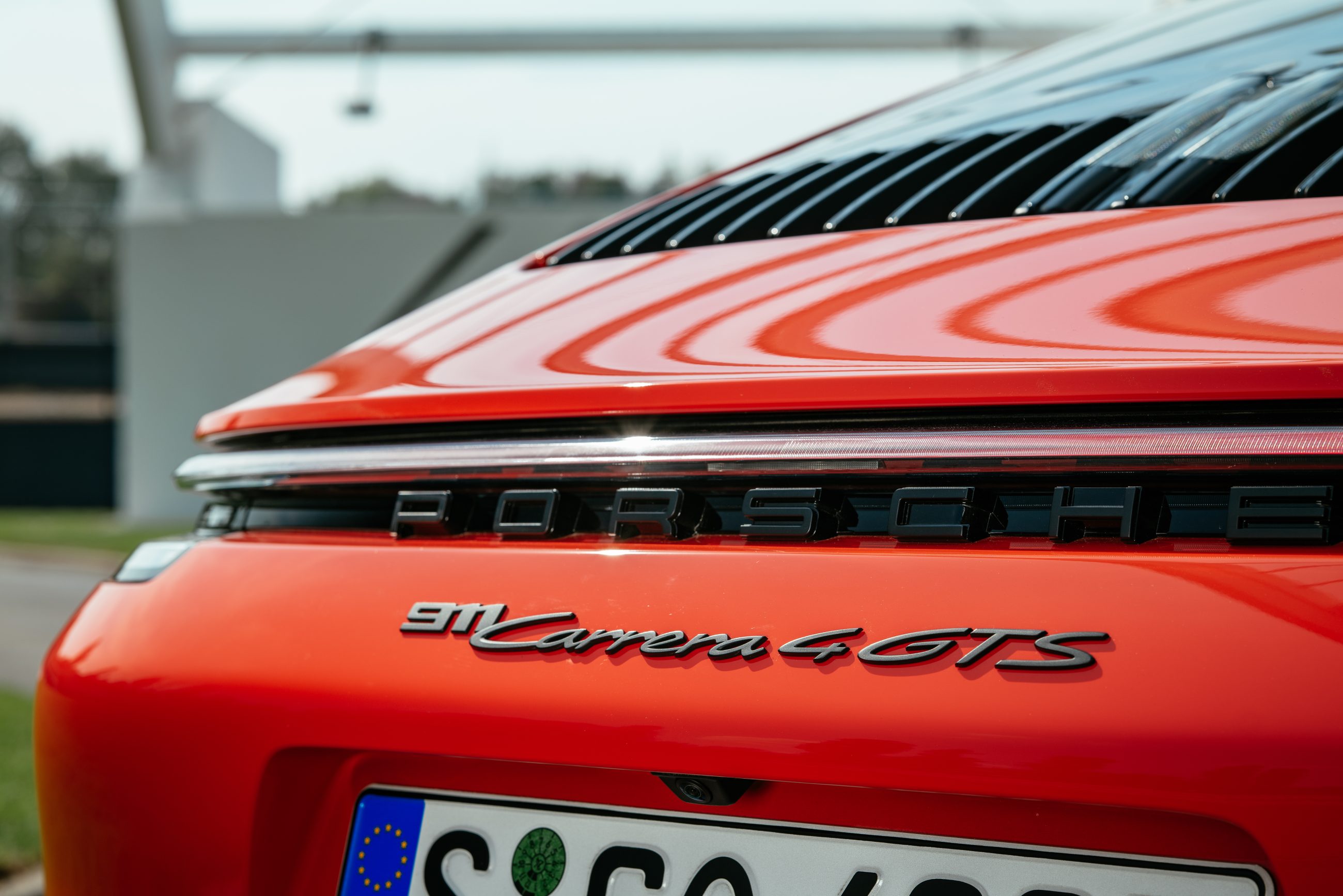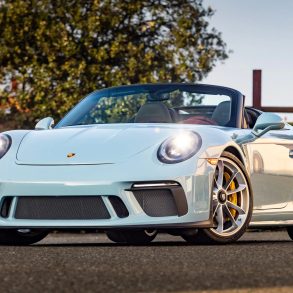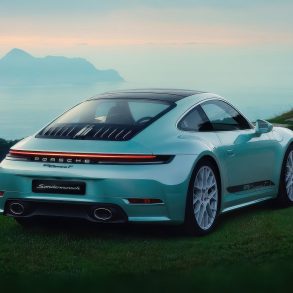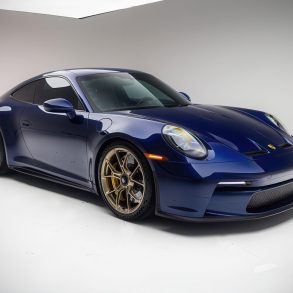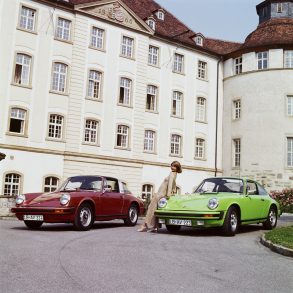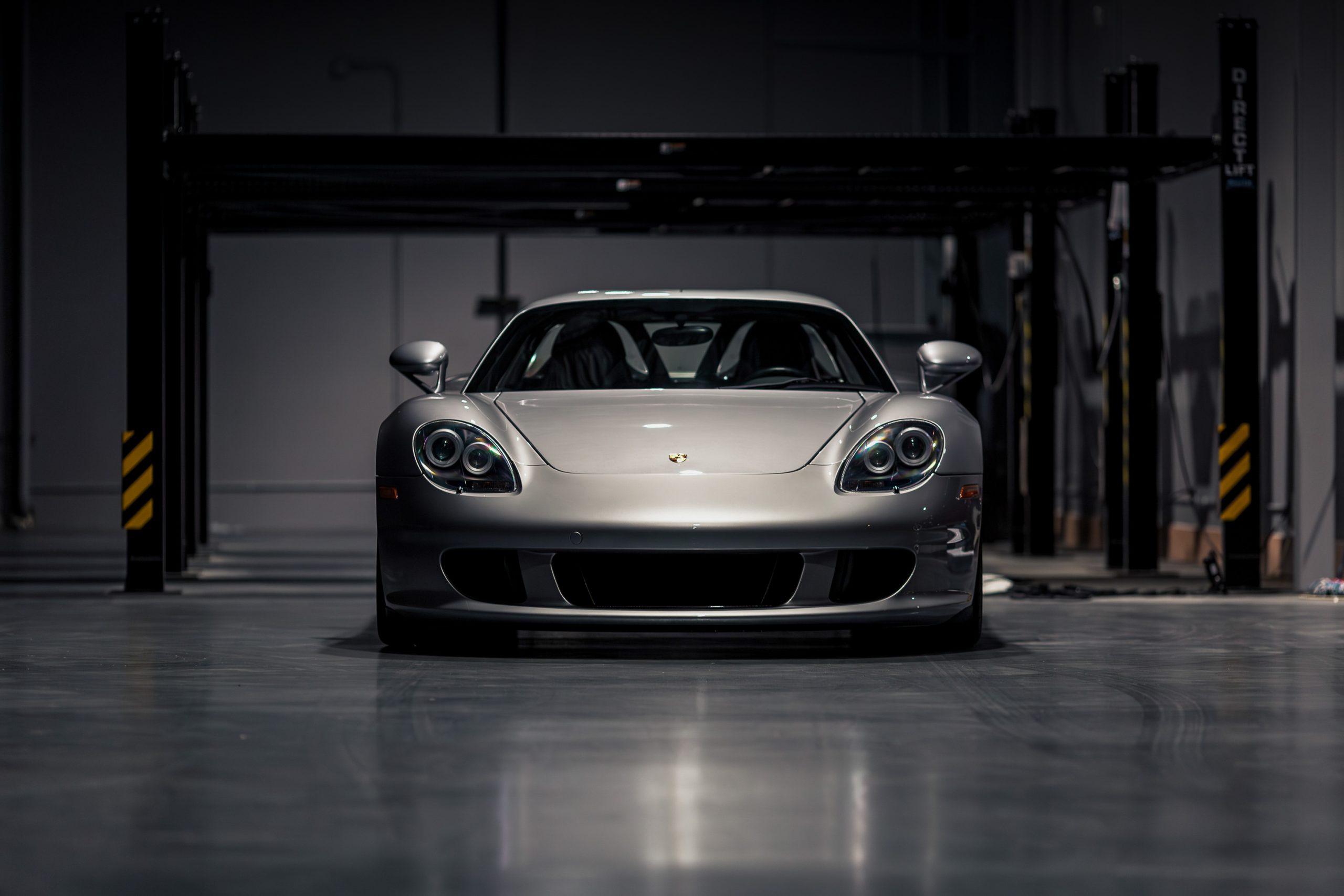2022 – 2024 Porsche 911 Carrera 4 GTS Coupe (992.1) – Reviews, Pricing, Specs & Buyers Guide
The 992.1 Porsche 911 Carrera 4 GTS Coupe is the “have-your-cake-and-eat-it” 911—more urgent and focused than a Carrera S, far more relaxed and usable than a GT-department car, and fitted with the hardware that matters on real roads. With 473 hp and 420 lb-ft from the twin-turbo 3.0-liter flat-six, all-wheel drive for all-season traction, standard PASM Sport (–10 mm) suspension, Turbo-grade brakes, and a GTS-specific sport exhaust backed by reduced cabin insulation, the 4 GTS finds an addictive balance of speed, grip, and civility. This guide covers its story, specs, model-year updates, how it drives, reception, options that matter, and buying advice.
Porsche introduced the 992-series GTS family on June 23, 2021, with U.S. deliveries starting for model year 2022. The headline: 473 hp (up 30 over Carrera S) and 420 lb-ft, achieved primarily via higher boost pressure, paired with a curated chassis package: PASM Sport lowered 10 mm, helper springs on the rear axle, Turbo-spec braking hardware, center-lock 20/21-inch wheels, a GTS-tuned sport exhaust, and less sound deadening for more character. The GTS range spanned rear- and all-wheel-drive Coupes and Cabriolets plus the Targa 4 GTS; this guide focuses on the Carrera 4 GTS Coupe (AWD).
Where earlier GTS models felt like well-optioned Carreras, the 992.1 recipe reads like a greatest-hits compilation from the Turbo and GT parts bins—chosen not for spec-sheet bragging, but for the way they transform the car’s feel at any speed. Porsche’s own technical materials highlight the rear-axle helper springs (borrowed from the Turbo) that keep the main springs under tension for consistent rebound behavior, and the adoption of center-lock wheels derived from the Turbo S.
Powertrain, Driveline & Chassis
Engine & Transmissions
- 3.0-liter twin-turbo flat-six (VTG): 473 hp / 420 lb-ft (U.S.).
- 8-speed PDK dual-clutch or 7-speed manual (short-throw lever). The GTS tune raises boost over the Carrera S for meaningful mid-range shove.
All-Wheel Drive (Carrera 4)
-
The 4 GTS uses an electronically controlled, water-cooled multi-plate clutch to engage the front axle rapidly—key to its repeatable launches and unflappable pace on cold or damp surfaces, as independent tests confirm.
Suspension & Brakes
- PASM Sport (–10 mm) with model-specific tuning; rear-axle helper springs for consistent rebound control.
- Turbo-spec iron brakes are standard; PCCB ceramic brakes are optional for high-temperature stability and lower unsprung mass.
- Wheels & Tires
-
Staggered 20-inch (front) / 21-inch (rear) wheels—center-lock design taken from Turbo S, with the option of five-lug wheels in some markets; typical rear tire fitment is 315/30 ZR21.
Exhaust & Character
-
A GTS-specific sport exhaust and the omission of part of the interior insulation provide a more emotive soundtrack without long-haul drone.
Infotainment
-
On January 24, 2022, Porsche rolled out a PCM 6.0 update for the 911 that improved the UI/voice system and added Android Auto support (CarPlay was already available). If seamless phone integration matters, ensure your car has this software level.
Performance: Paper vs. Reality
Porsche’s brochures are famously conservative, and the 4 GTS proves it. In MotorTrend’s instrumented testing, the 2022 Carrera 4 GTS (PDK) ran 0–60 mph in 3.0–3.1 seconds and the quarter-mile in 11.3–11.4 sec @ 120–123.5 mph; later, the same outlet listed the 4 GTS among its 10 Quickest Cars of 2022 with 2.8 seconds to 60 and a 10.9-second quarter @ 126.7 mph. That’s mid-pack supercar pace from a “mid-tier” 911 trim.
Car and Driver corroborated the GTS’s reality-defying speed: its PDK GTS hit 60 in 2.8 seconds, while the manual GTS still blasted the quarter in 11.3 sec @ 126 mph, one of the quickest three-pedal cars the magazine had ever timed. The AWD 4 GTS gives up little to the RWD car in the dry and is notably quicker and calmer when grip is marginal.
The Lightweight Package (Coupe-only highlight)
For the first time on a GTS, Porsche offered an optional Lightweight (Lightweight Design) Package on 992-generation Coupes. It cuts up to ~55 lb (25 kg) via CFRP full bucket seats, lightweight side/rear glass, a lightweight battery, and a rear-seat delete; it also adds rear-axle steering and extra aero underbody panels. The package doesn’t turn the 4 GTS into a GT3—what it does is sharpen responses and increase theater without wrecking ride quality, which reviewers consistently noticed. (The Cabriolet did not receive the full LW package.)
How It Drives
The 4 GTS’s defining trait is bandwidth. There’s big, immediate mid-range torque thanks to the higher-boost tune, so the car surges from low rpm in any gear. With PDK, launches are clinical and repeatable; the gearbox always seems to be in the right ratio and downshifts exactly when you think “now.” The AWD system adds a safety net that feels invisible most of the time and magical when the weather turns, letting you deploy power earlier and more often. On a wet, cold back road, the Carrera 4 GTS simply goes, which is why it keeps setting “how is this not a Turbo?” times in magazine testing.
The PASM Sport chassis is firmer than a Carrera S but not punishing on decent pavement. Helper springs keep the rear settled in transitions; rear-axle steering (if optioned or standard through the LW package) makes the car feel smaller in hairpins and calmer in high-speed sweepers. Brakes—borrowed from the Turbo—deliver massive, confidence-inspiring stops, and PCCB adds fade-proof stamina if you hammer mountain passes or do the occasional track session. The GTS-specific exhaust adds volume and texture without droning at highway speeds, and the slightly reduced insulation feeds more of that flat-six thrum into the cabin, especially in Sport/Sport Plus.
Detailed Specifications (Highlights)
- Engine: 3.0-liter twin-turbo flat-six (VTG) — 473 hp / 420 lb-ft
- Transmissions: 8-spd PDK or 7-spd manual
- Driveline: AWD (Carrera 4) with water-cooled, electronically controlled front clutch
- Chassis: PASM Sport (–10 mm), helper springs on rear axle; rear-axle steering optional (standard with the LW package)
- Brakes: Turbo-derived iron rotors; PCCB optional
- Wheels/Tires: 20 in (F) / 21 in (R); center-lock design available (from Turbo S)
- Performance (tested): 0–60 mph as low as 2.8–3.0 s, ¼-mile 10.9–11.4 s depending on spec/conditions
- Infotainment: PCM 6.0 with Android Auto (Jan 24, 2022 update) and Apple CarPlay
Model-Year Updates (2022–2024)
- 2022 (launch year): The Carrera 4 GTS Coupe arrives with 473 hp/420 lb-ft, PASM Sport (–10 mm), helper springs, Turbo-spec brakes, Sport Chrono, reduced insulation, and GTS visuals. PCM 6.0 receives a January 24, 2022 update that adds Android Auto and UI improvements to compatible 911s.
- 2023: Running refinements and option reshuffles; the Lightweight Package remains available on the Coupe with its ~55-lb reduction and bundled rear-axle steering. Independent testing continues to highlight the 4 GTS’s supercar-adjacent acceleration.
- 2024 (final 992.1 year): The recipe carries forward essentially unchanged ahead of the 992.2 refresh. Context for buyers: the 2025 992.2 Carrera GTS adopts a T-Hybrid system and posts even faster numbers, which also cements 2022–2024 as the last pure-ICE GTS era.
Reception & Reviews
- MotorTrend (First Test, 2022 4 GTS): “Marked improvement” over previous-gen GTS with 3.0–3.1 s to 60 mph and 11.3–11.4 s quarter miles early on; later listed the 4 GTS in the 10 Quickest Cars of 2022 at 2.8 s / 10.9 s @ 126.7 mph. The key takeaway was breadth: blistering when asked, civil the rest of the time.
- Car and Driver (GTS by the Numbers): 2.8 s to 60 mph for the PDK car and a 11.3-sec @ 126 mph quarter for the manual—one of the quickest three-pedal tests they’ve recorded—while praising the GTS’s curated suspension, mounts, exhaust, and brakes.
Across outlets, the consensus is clear: the Carrera 4 GTS is the sweet-spot 911 for real-world driving—nearly Turbo-quick when you stand on it, yet composed, tractable, and comfortable when you don’t.
Options & Packages That Matter
- Rear-Axle Steering (RAS): Transforms the 4 GTS on tight roads and steadies it at speed; standard if you spec the Lightweight Package, otherwise a highly recommended option.
- PCCB (carbon ceramics): Outstanding fade resistance and pedal consistency with reduced unsprung mass. Worth it for mountain driving or frequent high-load use; inspect carefully when buying used.
- Lightweight Package (Coupe): If you want a touch more edge and drama without going full GT3, this is the one—CFRP buckets, light glass/battery, rear-seat delete, RAS, extra aero, ~55 lb saved.
- Five-lug wheels (where offered): If you swap tires often, five lugs simplify life versus center-locks with negligible real-world performance tradeoff.
- Driver assistance & lift: Front-axle lift protects the splitter; adaptive cruise and blind-spot monitoring add daily-driver polish without diluting the experience.
Buying Guide (Used)
- Spec verification. If a car is advertised as Lightweight Package, check the build sheet for CFRP buckets, rear-seat delete, lightweight glass/battery, RAS, underbody aero—don’t assume from photos. The package was coupe-specific in this era.
- Wheels & tires. Inspect 21-inch rear inner shoulders for accelerated wear; confirm proper torque and service history on center-locks if fitted. A fresh, quality alignment makes a noticeable difference (RAS cars are particularly sensitive).
- Brakes. Turbo-grade iron brakes are robust. On PCCB, examine rotor faces for stone nicks and confirm there’s no pedal pulsation.
- Software & infotainment. Confirm the PCM 6.0 Jan 24, 2022 software update if Android Auto matters to you.
- Provenance & warranty. The 992 platform is stout. Prioritize a clean service history, matched Porsche-approved tires, and an unmodified ECU if warranty coverage is in play.
Ownership Experience & Verdict
Live with a 4 GTS and it feels disarmingly easy. Visibility is excellent, the cabin is ergonomic and restrained, and PASM Normal makes commuting straightforward. Ask for more and it obliges with repeatable thrust, crisp gearing, and the kind of calm, confidence-building traction that lets you explore performance more often—not just on postcard-perfect days. That, more than any single stat, is what makes the 4 GTS special: it’s the 911 that’s fast most of the time, for most drivers, in most conditions.
For MY2025, the refreshed 992.2 Carrera GTS adopted T-Hybrid assistance and set even quicker numbers (as low as 2.5 s to 60 mph in Car and Driver testing). That shift also freezes 2022–2024 as the last pure-ICE Carrera 4 GTS era—useful context for buyers who value mechanical simplicity and long-term character.
If your ideal 911 needs to crush poor weather, devour distance, and still feel special at 30 mph or 130, the Carrera 4 GTS Coupe (992.1) is bull’s-eye. Start with PDK for maximum pace or the 7-MT for involvement. Add RAS (or the Lightweight Package if you want the sharper, more visceral coupe) and consider PCCB if you live in the mountains. Verify the PCM 6.0 update if smartphone integration matters. Do that, and you’ll own the 911 that best balances outright speed with huge usable bandwidth—a car that feels like it was built for the way you actually drive.
What We Said At Launch
Porsche’s GTS models exist to bridge the gap between the already solid Carrera 4S and the ultra-high-performance GT3 and Turbo versions. While in years gone by you could probably option a Carrera 4S to give you a pseudo Carrera 4 GTS, those days are long gone.
The main issue is the engine. In the past, Porsche offered an optional factory “power kit” for 911 Carreras, but things are different now. That isn’t an option for the 992. The 992 Porsche 911 Carrera 4 GTS is therefore your only pass for accessing a version of the 3.0-liter twin-turbo flat-six tuned up to 473 hp and 420 ft lbs of torque. Those figures are achieved via an approximately 14.5 percent increase in turbo boost pressure (the peak is now 18.3 psi), and they reflect improvements of 30 hp and 30 ft lbs compared to the 992 Carrera 4S. The only actual engine-hardware upgrade, Porsche says, is a strengthened dual-mass flywheel to cope with the additional torque.
The changes that mark the GTS out from the lowlier 911s when it comes to design, are pretty subtle. The ride height has been cut by 10mm, there’s lots of black trim and the sports body kit – which is optional on the basic Carrera – comes as standard. Inside, only the GTS logos and extra black trim mark the GTS out from a standard 911. The Carrera 4 GTS looks more sinister for sure, and we love the touches.
The engine is the same 3.0-litre, twin-turbocharged flat-six petrol engine as in the 911 Carrera S, but it has been fettled to produce 473 bhp @ 6500 rpm – an increase of 30hp over the S and 95hp over the basic 911 Carrera. The GTS also has a bespoke suspension set-up that sits 10mm lower than the standard 911, and that’s true no matter whether you choose two- or four-wheel drive. The result is a car that feels more aggressive, but it’s just as practical and well equipped. The basic 911’s rear seats are still in situ, and there’s the same 132-litre luggage bay at the front. And because this isn’t quite as hardcore as some high-performance track cars, there’s still a proper touchscreen infotainment system and comfortable seats.
Most of the time, there’s absolutely no difference between the standard GTS and the all-wheel-drive version. On the public road, the two cars feel like peas in a pod, with the Carrera 4 marked out only by a natty digital display in the instrument binnacle that shows you how much power is going to each wheel. That betrays just how rear-biased the all-wheel-drive system is, with almost all the grunt going to the back unless it’s desperately needed elsewhere. A pootle through town – even on a wet day – is highly unlikely to coax any meaningful amount of power to switch from the rear to the front.
The 4 GTS feels so similar to the two-wheel-drive car almost all the time. Like on the 911 Carrera 4S, the all wheel drive system was further developed from the last generation. The increased performance is thanks to further development of the front axle drive. The clutch and differential unit are now water-cooled and have reinforced clutches to increase durability and load capacity. The increased actuating torques of the clutches improve the latter’s adjustment accuracy and thus the capability of the driven front axle. The enhanced front axle drive in combination with Porsche Traction Management (PTM) promote a further enhancement to the already impressive traction on snow, as well as in wet and dry conditions. The GTS models have been tuned to offer stability in high-speed corners and unparalleled agility, but that comes at the cost of ride comfort. For day-to-day driving, a 4S is going to be more pleasant, even if you specify the optional ride height reduction.
Realistically, there are only two places that will show off the Carrera 4 GTS’s all-wheel-drive system: a racetrack and a snowy road. On the former, the 4 GTS puts its power down slightly more effectively, and that means it’s a tenth of a second faster to 100km/h than the standard GTS, hitting the benchmark speed after just 3.3 seconds. However, with a top speed of 309km/h, the all-wheel-drive car is marginally slower at full chat.
None of that really matters, partly because such differences are so minor, and partly because both cars are fast by anyone’s measure. But barroom bragging rights will hold some sway among Porsche customers, so it’s worth mentioning. Perhaps less important is the minute fuel economy penalty that sees the 4 GTS burn between 10.6- and 11.4 litres of unleaded per 100km, whereas the standard GTS will manage 10.4-11.4 litres/100km.
The most important differences between the two- and four-wheel-drive versions of the GTS will be found when the weather turns nasty. The four-wheel-drive car offers that bit more security on wet and icy roads, and it reduces the chances of being snowed in during winter. It’ll also allow slightly more traction on grass, if you ever need it. Of course, the best way to combat rough weather is with winter or all-season tyres, and a 4 GTS with winter rubber is going to feel much more stable when the snow comes down. The Carrera 4 GTS’s appeal lies in its utility. With all-wheel drive on board, there’s a safety net; peace of mind that when the rain or snow begins to fall, the car won’t have to stay in the garage. For those who live in places where the winters are harsh and the summers only last for a week, it’s an easy decision. And for those who plan to go to one of those places, it’s still probably worth specifying.
Videos & Reviews
Pictures
Press Release
June 22, 2021
More distinctive and dynamic than ever: the new 2022 Porsche 911 GTS models
Five model variants are being added to the successful 911 range
Atlanta. Twelve years ago, the very first GTS version of the 911 was introduced – featuring a series of very targeted modifications that, when brought together combined to make a difference – as a more focused, more dynamic and faster 911 that retained the subtly and usability of the car on which it was based. Following a familiar theme, a new generation of the popular sports car model is being launched. More powerful and visually distinctive, and with better driving dynamics than ever, the six-cylinder boxer engine at the heart of the 911 GTS delivers 473 hp, which is 30 hp more than the current 911 Carrera S and 23 hp over the previous 911 GTS. Torque rises to 420 lb-ft.
The result of this extra potency is a zero to 60 mph sprint of just 3.1 seconds in the case of the 911 Carrera 4 GTS coupe equipped with the eight-speed Porsche dual-clutch transmission (PDK): three tenths faster than its predecessor. A seven-speed manual transmission with a gear lever shortened by 10 millimeters is available for all 911 GTS models as an alternative to the PDK.
The 911 GTS is available in five variants:
- 911 Carrera GTS with rear-wheel drive, as Coupe and Cabriolet
- 911 Carrera 4 GTS with all-wheel drive, as Coupe and Cabriolet
- 911 Targa 4 GTS with all-wheel drive
Joining the increase in power is GTS-specific suspension tuning with Porsche Active Suspension Management (PASM), and the high-performance braking system from the 911 Turbo. Driving dynamics can improve even more through the optional Lightweight package, which will be available on the 911 Carrera GTS coupe models for the first time, saving up to 55 lbs. in weight. Setting the 911 GTS apart is black contrasting bodywork elements and darkened headlight housings. Inside, the interior features many of the touchpoints finished in grippy Race-Tex cloth material. The latest generation of Porsche Communication Management (PCM) brings numerous improvements in operation and connectivity. Technology: bespoke suspension and unique Sport Exhaust system Derived from the 911 Turbo and modified for the GTS coupe and Cabriolet models, the suspension meets exacting performance demands – with Porsche Active Suspension Management (PASM) Sport suspension that lowers the ride height by 10 millimeters featuring as standard equipment. The suspension includes helper springs at the rear to help maintain tension on the main springs in all driving conditions, meaning rebound characteristics are consistent. As in the previous generation, the 911 Targa GTS is an exception, sharing its chassis with the 911 Targa 4S.
The engineers in Weissach have also adjusted stopping performance to match the increased performance of the GTS, which makes use of the high-performance braking system from the 911 Turbo. The 20-inch (front) and 21-inch (rear) black, center-lock alloy wheels have a design derived from the 911 Turbo S. The standard Sport exhaust system is responsible for an even more emotive soundtrack, thanks to its GTS-specific set-up and a reduction in sound deadening material.
Exterior: numerous black accents in satin or high gloss
A multitude of black or darkened exterior details are characteristic of the 911 GTS models. On the 911 Targa 4 GTS, this also includes the model-defining Targa bar and Targa lettering. Additional elements painted in Satin Black include the spoiler lip, the center-lock alloy wheels, the engine cover grille, and the GTS script on the doors and rear of the car. The exterior package, in which these and other details are executed in high-gloss black is optionally available. All 911 GTS models effectively have the SportDesign package, with distinctive trim for the front, rear and the side sills. The headlight trims and daytime running light surrounds are darkened, and the car is fitted with standard LED headlights with Porsche Dynamic Light System Plus (PDLS Plus). The rear lights are also darkened. Satin Black accents characterize the model designation, PORSCHE lettering and charge-air grille slats above the engine.
Lightweight package: less weight
Driving dynamics are further improved with the Lightweight package, which will be available for the first time on a GTS. Up to 55 lbs. can be saved by the lighter carbon fiber full bucket seats, lightweight glass for the side and rear windows, and the use of a lightweight battery. The rear seats are also removed. Other performance enhancements include rear-axle steering as part of this equipment package and additional aerodynamic underbody paneling.
Interior: black Race-Tex and standard Sport Seats Plus
The sporty details of the GTS models continue inside functionally as well as visually. The gear lever of the optional seven-speed manual transmission has been shortened by 10 mm, which enables fast gear shifts with a flick of the wrist. A GT Sport steering wheel as well as the Sport Chrono package with mode switch, Porsche Track Precision app and a tire temperature display are standard features. The standard Sport Seats Plus with electric four-way adjustment provide lateral support, comfort and convenience. The interior insulation has been reduced.
Numerous Race-Tex features underscore the elegant dynamic ambience. The seat centers, the steering wheel rim, door handles and armrests, storage compartment lid and gear lever are all trimmed in Race-Tex. With the optional GTS interior package, the stitching is available in Carmine Red or Chalk. The seatbelts and embroidered GTS lettering on the headrests, tachometer and Sport Chrono clock come in the same contrasting colors. Carbon fiber interior trim panels complete the package.
New display and operating concept: now also with Android Auto
The new generation of the Porsche Communication Management (PCM) features additional functions and significantly simplified operation. The touch icons in the Media menu have been enlarged and the option of rearranging the tiles on the home screen is new. The improved voice assistant recognizes natural speech and can be activated with “Hey Porsche.” iOS and Android users will enjoy standard Wireless Apple CarPlay® and now wired Android Auto™.
First deliveries for the US are expected in early 2022 with a starting MSRP of $136,700 excluding $1,350 for delivery, processing, and handling.
- 911 Carrera GTS $136,700
- 911 Carrera GTS Cabriolet $149,500
- 911 Carrera 4 GTS $144,000
- 911 Carrera 4 GTS Cabriolet $156,800
- 911 Targa 4 GTS $156,800


